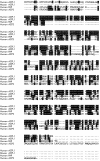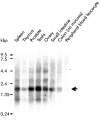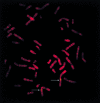Novel human and mouse genes encoding an acid phosphatase family member and its downregulation in W/W(V) mouse jejunum
- PMID: 12010880
- PMCID: PMC1773242
- DOI: 10.1136/gut.50.6.790
Novel human and mouse genes encoding an acid phosphatase family member and its downregulation in W/W(V) mouse jejunum
Abstract
Background and aims: Interstitial cells of Cajal (ICC) are pacemakers and mediators of motor neurotransmission in gastrointestinal smooth muscles. ICC require cellular signalling via Kit, a receptor tyrosine kinase, for development and maintenance of phenotype. Much of the evidence demonstrating the functions of ICC comes from studies of W/W(V) mice, which have reduced Kit function and reductions in specific populations of ICC. The aim of the present study was to differentially examine gene expression in the small intestines of wild-type and W/W(V) mutant mice.
Methods and results: RNA from the jejunums of wild-type and W/W(V) mutants was analysed using a differential gene display method. Eighteen queries were identified as novel genes that were differentially displayed in wild-type and W/W(V) mice. One candidate gene, encoding a novel acid phosphatase-like protein, was significantly suppressed in fed and starved W/W(V) mice. The full length clone of the murine gene and its human counterpart were designated acid phosphatase-like protein 1 (ACPL1). Human ACPL1 cDNA encodes a protein of 428 amino acids with homology to human prostatic acid phosphatase protein. This gene is located at 1q21. ACPL1 was abundantly expressed in the human small intestine and colon. Gene products were found to be cytoplasmic in transfected COS-7 cells. Reverse transcription-polymerase chain reaction analysis revealed expression of ACPL1 mRNA within single isolated ICCs.
Conclusions: Gene analysis showed that ACPL1 was differentially expressed in the small intestines of normal and W/W(V) mice. ICC within the small intestine expressed mRNA for ACPL1. Specific downregulation of ACPL1 in the jejunums of W/W(V) mice and high expression in human intestinal tissue suggest that the ACPL1 gene could be associated with ICC function in mice and humans.
Figures







Similar articles
-
Differential gene expression profile in the small intestines of mice lacking pacemaker interstitial cells of Cajal.BMC Gastroenterol. 2003 Jun 29;3:17. doi: 10.1186/1471-230X-3-17. BMC Gastroenterol. 2003. PMID: 12831403 Free PMC article.
-
Novel human, mouse and xenopus genes encoding a member of the RAS superfamily of low-molecular-weight GTP-binding proteins and its downregulation in W/WV mouse jejunum.J Gastroenterol Hepatol. 2004 Feb;19(2):211-7. doi: 10.1111/j.1440-1746.2004.03298.x. J Gastroenterol Hepatol. 2004. PMID: 14731133
-
Novel human and mouse genes encoding a shank-interacting protein and its upregulation in gastric fundus of W/WV mouse.J Gastroenterol Hepatol. 2003 Jun;18(6):712-8. doi: 10.1046/j.1440-1746.2003.03046.x. J Gastroenterol Hepatol. 2003. PMID: 12753155
-
Isolation of novel mouse genes that were differentially expressed in W/W(V) mouse fundus.J Gastroenterol. 2004;39(3):238-41. doi: 10.1007/s00535-003-1283-8. J Gastroenterol. 2004. PMID: 15065000
-
[Roles of interstitial cells of Cajal in regulation of motility of the mouse intestine].Nihon Yakurigaku Zasshi. 2004 Mar;123(3):170-8. doi: 10.1254/fpj.123.170. Nihon Yakurigaku Zasshi. 2004. PMID: 14993729 Review. Japanese.
Cited by
-
Differential gene expression in the murine gastric fundus lacking interstitial cells of Cajal.BMC Gastroenterol. 2003 Jun 10;3:14. doi: 10.1186/1471-230X-3-14. BMC Gastroenterol. 2003. PMID: 12795813 Free PMC article.
-
Differential gene expression profile in the small intestines of mice lacking pacemaker interstitial cells of Cajal.BMC Gastroenterol. 2003 Jun 29;3:17. doi: 10.1186/1471-230X-3-17. BMC Gastroenterol. 2003. PMID: 12831403 Free PMC article.
References
-
- Huizinga JD, Thuneberg L, Kluppel M, et al. W/Kit gene required for interstitial cells of Cajal and for intestinal pacemaker activity. Nature (Lond) 1995;373:347–9. - PubMed
Publication types
MeSH terms
Substances
Associated data
- Actions
- Actions
Grants and funding
LinkOut - more resources
Full Text Sources
Molecular Biology Databases
Research Materials
